

Compact Muon Solenoid
LHC, CERN
| CMS-PAS-BPH-14-009 | ||
| Dependence of the $\Upsilon$(nS) production ratios on charged particle multiplicity in pp collisions at $\sqrt{s}= $ 7 TeV | ||
| CMS Collaboration | ||
| October 2016 | ||
| Abstract: The ratios of the cross section of the $\Upsilon$(nS) mesons with $|y|<1.2$ are studied as a function of the number of charged particles with $p_{\mathrm{T}}> $ 0.4 GeV and $|\eta|< $ 2.4 produced in pp collisions at $\sqrt{s}= $ 7 TeV. Evidence of a decrease of the ratios between the higher and the lower mass states is observed, that is more pronounced at lower $p_{\mathrm{T}}$. For $\Upsilon$(nS) mesons of transverse momentum greater than 7 GeV, this effect is studied as a function of the underlying event sphericity, and of the distribution of charged particles with respect to the $\Upsilon$(nS) direction. | ||
|
Links:
CDS record (PDF) ;
CADI line (restricted) ;
These preliminary results are superseded in this paper, JHEP 11 (2020) 001. The superseded preliminary plots can be found here. |
||
| Figures | |
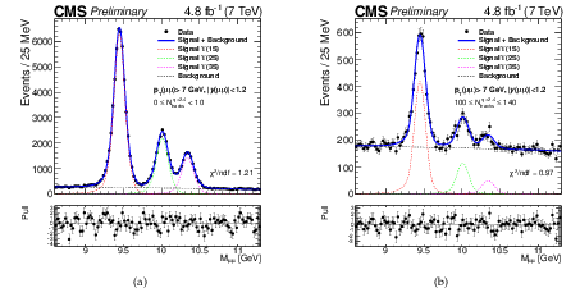
png pdf |
Figure 1:
Fit to the mass spectrum of dimuon candidates with $p_{\mathrm{T}} > $ 7 GeV and $|y| < $ 1.2, in two ranges of charged particle multiplicity 0-10 (a) and 100-140 (b). |
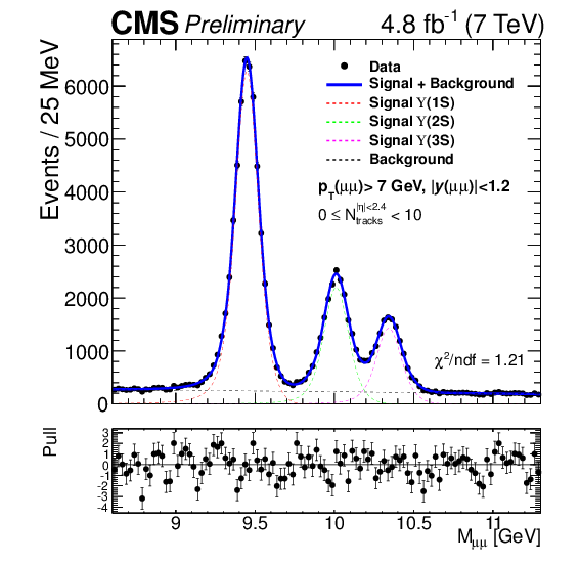
png pdf |
Figure 1-a:
Fit to the mass spectrum of dimuon candidates with $p_{\mathrm{T}} > $ 7 GeV and $|y| < $ 1.2, in two ranges of charged particle multiplicity 0-10. |

png pdf |
Figure 1-b:
Fit to the mass spectrum of dimuon candidates with $p_{\mathrm{T}} > $ 7 GeV and $|y| < $ 1.2, in two ranges of charged particle multiplicity 100-140. |

png pdf |
Figure 2:
Production ratios for $\Upsilon$(2S)/$\Upsilon$(1S) and $\Upsilon$(2S)/$\Upsilon$(1S) in (a), and $\Upsilon$(3S)/$\Upsilon$(2S) in (b) as a function of N$^{|\eta |<2.4}_{tracks}$. The $\Upsilon$ states satisfy $ {p_{\mathrm {T}}} >$ 7 GeV and $|y|< $ 1.2, while tracks are counted for $|\eta | <$ 2.4 and ${p_{\mathrm {T}}} > $ 0.4 GeV. Error bars represent statistical uncertainties, while empty squares show the systematic ones. |

png pdf |
Figure 2-a:
Production ratios for $\Upsilon$(2S)/$\Upsilon$(1S) and $\Upsilon$(2S)/$\Upsilon$(1S) as a function of N$^{|\eta |<2.4}_{tracks}$. The $\Upsilon$ states satisfy $ {p_{\mathrm {T}}} >$ 7 GeV and $|y|< $ 1.2, while tracks are counted for $|\eta | <$ 2.4 and ${p_{\mathrm {T}}} > $ 0.4 GeV. Error bars represent statistical uncertainties, while empty squares show the systematic ones. |

png pdf |
Figure 2-b:
Production ratios for $\Upsilon$(3S)/$\Upsilon$(2S) as a function of N$^{|\eta |<2.4}_{tracks}$. The $\Upsilon$ states satisfy $ {p_{\mathrm {T}}} >$ 7 GeV and $|y|< $ 1.2, while tracks are counted for $|\eta | <$ 2.4 and ${p_{\mathrm {T}}} > $ 0.4 GeV. Error bars represent statistical uncertainties, while empty squares show the systematic ones. |
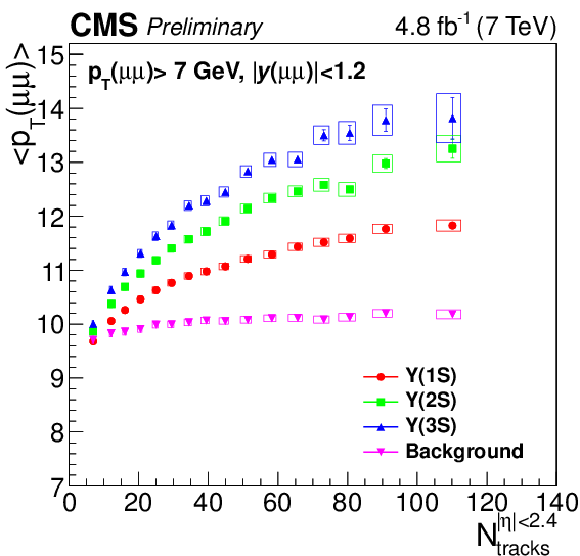
png pdf |
Figure 3:
Mean $p_{\mathrm{T}}$ for the three $\Upsilon$ states, as well as of the sideband background , as a function of multiplicity. The $\Upsilon$ states satisfy $ {p_{\mathrm {T}}} > $ 7 GeV and $|y|< $ 1.2, while charged particles are counted for $|\eta | <$ 2.4 and ${p_{\mathrm {T}}} > $ 0.4 GeV. Error bars represent statistical uncertainties, while empty squares are the systematic uncertainties. |

png pdf |
Figure 4:
Production ratios vs multiplicity for $\Upsilon$(2S)/$\Upsilon$(1S) in (a), $\Upsilon$(3S)/$\Upsilon$(1S) in (b), $\Upsilon$(3S)/$\Upsilon$(2S) in (c) in different regions of ${p_{\mathrm {T}}} $. $\Upsilon$ states satisfy $|y|< $ 1.2, while tracks are counted for $|\eta | <$ 2.4 and ${p_{\mathrm {T}}} > $ 0.4 GeV. Error bars represent statistical uncertainties, while empty squares show the systematic ones. |
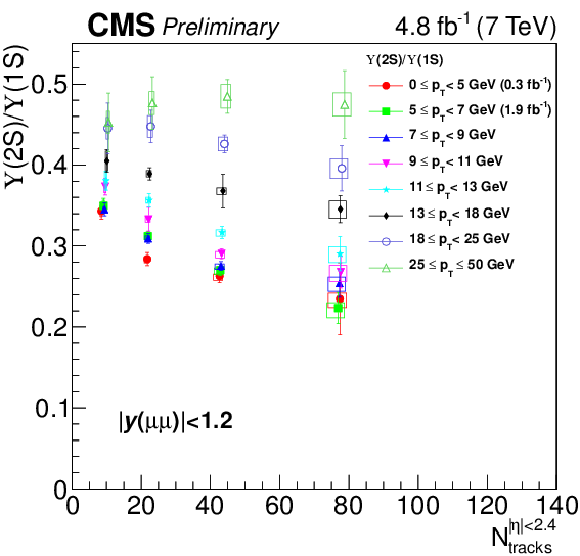
png pdf |
Figure 4-a:
Production ratios vs multiplicity for $\Upsilon$(2S)/$\Upsilon$(1S) in different regions of ${p_{\mathrm {T}}} $. $\Upsilon$ states satisfy $|y|< $ 1.2, while tracks are counted for $|\eta | <$ 2.4 and ${p_{\mathrm {T}}} > $ 0.4 GeV. Error bars represent statistical uncertainties, while empty squares show the systematic ones. |

png pdf |
Figure 4-b:
Production ratios vs multiplicity for $\Upsilon$(3S)/$\Upsilon$(1S) in different regions of ${p_{\mathrm {T}}} $. $\Upsilon$ states satisfy $|y|< $ 1.2, while tracks are counted for $|\eta | <$ 2.4 and ${p_{\mathrm {T}}} > $ 0.4 GeV. Error bars represent statistical uncertainties, while empty squares show the systematic ones. |

png pdf |
Figure 4-c:
Production ratios vs multiplicity for $\Upsilon$(3S)/$\Upsilon$(2S) in different regions of ${p_{\mathrm {T}}} $. $\Upsilon$ states satisfy $|y|< $ 1.2, while tracks are counted for $|\eta | <$ 2.4 and ${p_{\mathrm {T}}} > $ 0.4 GeV. Error bars represent statistical uncertainties, while empty squares show the systematic ones. |

png pdf |
Figure 5:
In (a), the schematic view of the tracks kinematic regions in the azimuthal plane with respect to the $\Upsilon$(nS) direction. In (b), the production ratios for $\Upsilon$(2S) and $\Upsilon$(3S) over $\Upsilon$(1S) as a function of N$^{|\eta |<2.4}_{tracks}$ measured in the kinematic regions shown in (a). The $\Upsilon$ states satisfy $ {p_{\mathrm {T}}} > $ 7 GeV and $|y|< $ 1.2, while charged particles are counted for $|\eta ^{tracks}| <$ 2.4 and $ {p_{\mathrm {T}}} ^{tracks} > $ 0.4 GeV. Error bars represent statistical uncertainties, while empty squares show the systematic one. |
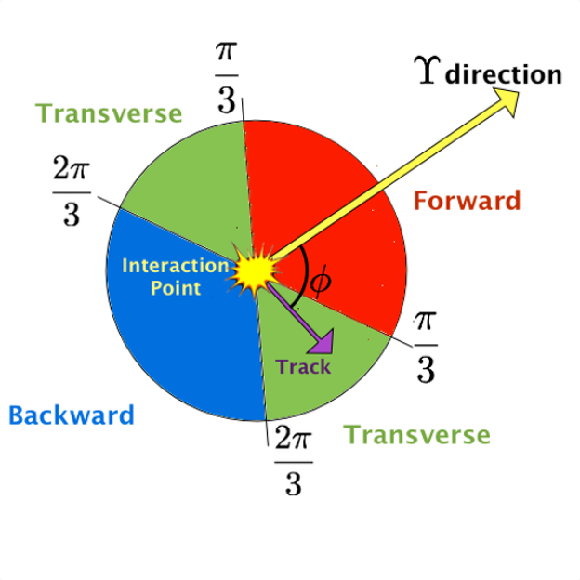
png pdf |
Figure 5-a:
The schematic view of the tracks kinematic regions in the azimuthal plane with respect to the $\Upsilon$(nS) direction. |
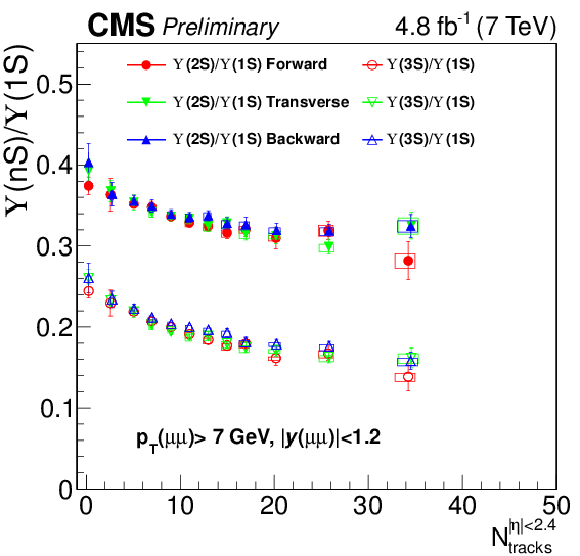
png pdf |
Figure 5-b:
The production ratios for $\Upsilon$(2S) and $\Upsilon$(3S) over $\Upsilon$(1S) as a function of N$^{|\eta |<2.4}_{tracks}$ measured in the kinematic regions shown in Fig. 5-a. The $\Upsilon$ states satisfy $ {p_{\mathrm {T}}} > $ 7 GeV and $|y|< $ 1.2, while charged particles are counted for $|\eta ^{tracks}| <$ 2.4 and $ {p_{\mathrm {T}}} ^{tracks} > $ 0.4 GeV. Error bars represent statistical uncertainties, while empty squares show the systematic one. |

png pdf |
Figure 6:
Production ratios as a function of N$^{|\eta |< 2.4}_{tracks}$ for $\Upsilon$(2S)/$\Upsilon$(1S) and $\Upsilon$(3S)/$\Upsilon$(1S), in different intervals of events sphericity. The $\Upsilon$ states satisfy $ {p_{\mathrm {T}}} > $ 7 GeV and $|y|< $ 1.2, while charged particles are counted for $|\eta | <$ 2.4 and ${p_{\mathrm {T}}} > $ 0.4 GeV. Error bars represent statistical uncertainties, while empty squares are the systematic ones. |
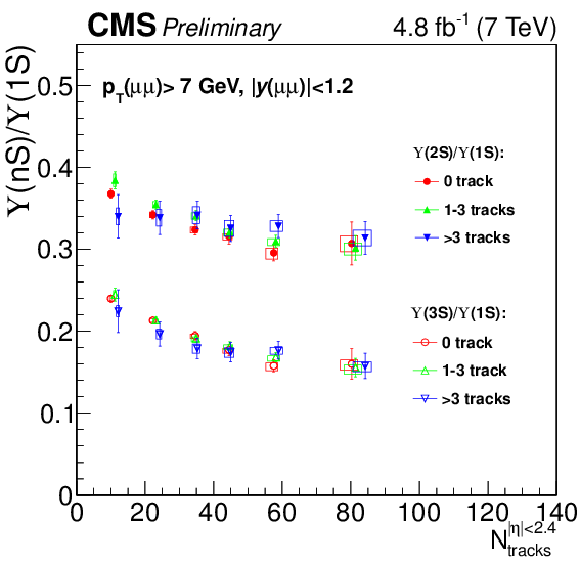
png pdf |
Figure 6-a:
Production ratios as a function of N$^{|\eta |< 2.4}_{tracks}$ for $\Upsilon$(2S)/$\Upsilon$(1S) and $\Upsilon$(3S)/$\Upsilon$(1S), in three categories based on the number of charged particles produced in a cone $\Delta \mathrm{R} < $ 0.5 around the $\Upsilon$ direction. The $\Upsilon$ states satisfy $ {p_{\mathrm {T}}} > $ 7 GeV and $|y|< $ 1.2, while charged particles are counted for $|\eta | <$ 2.4 and ${p_{\mathrm {T}}} > $ 0.4 GeV. Error bars represent statistical uncertainties, while empty squares are the systematic ones. |

png pdf |
Figure 6-b:
Production ratios as a function of N$^{|\eta |< 2.4}_{tracks}$ for $\Upsilon$(2S)/$\Upsilon$(1S) and $\Upsilon$(3S)/$\Upsilon$(1S), in different intervals of events sphericity. The $\Upsilon$ states satisfy $ {p_{\mathrm {T}}} > $ 7 GeV and $|y|< $ 1.2, while charged particles are counted for $|\eta | <$ 2.4 and ${p_{\mathrm {T}}} > $ 0.4 GeV. Error bars represent statistical uncertainties, while empty squares are the systematic ones. |
| Summary |
| We have measured the ratio between the $\Upsilon$(nS) yields in pp collisions at $\sqrt{s}=$ 7 TeV as a function of the number of charged particles produced with $|\eta| <$ 2.4 and $ p_{\mathrm{T}} >$ 0.4 GeV. We observe a significant reduction of the ratios of high over low mass $\Upsilon$ yields with increasing multiplicity. This result extends the observation in pp and pPb collisions in Ref. [1]. The effect is visible in different ranges of $ p_{\mathrm{T}} $, but decreases with increasing $ p_{\mathrm{T}} $. With the larger statistic available for $\Upsilon$(nS) with $ p_{\mathrm{T}} > $ 7 GeV, different observables were studied in order to obtain a better description of the phenomenology in connection with the underlying event. We found no link between the relative direction of the charged particles with respect to the direction of the $\Upsilon$ and no strong dependence on the event sphericity, while we observe a flattening of the $\Upsilon$(2S) /$\Upsilon$(1S) multiplicity dependence when a large number of particles is present in a strict cone around the $\Upsilon$ direction. |
| References | ||||
| 1 | CMS Collaboration | Event activity dependence of Y(nS) production in $ \sqrt{s_{NN}} $=5.02 TeV pPb and $ \sqrt{s} $=2.76 TeV pp collisions | JHEP 04 (2014) 103 | CMS-HIN-13-003 1312.6300 |
| 2 | ALICE Collaboration | $ J/\psi $ Production as a Function of Charged Particle Multiplicity in $ pp $ Collisions at $ \sqrt{s} = 7 $ TeV | PLB 712 (2012) 165 | 1202.2816 |
| 3 | ALICE Collaboration | D-meson production in p-Pb collisions at $ \sqrt{s_{\rm NN}}=5.02 $ TeV and in pp collisions at $ \sqrt{s}=7 $ TeV | 1605.07569 | |
| 4 | CMS Collaboration | Observation of Long-Range Near-Side Angular Correlations in Proton-Proton Collisions at the LHC | JHEP 09 (2010) 091 | CMS-QCD-10-002 1009.4122 |
| 5 | ATLAS Collaboration | Observation of Long-Range Elliptic Azimuthal Anisotropies in $ \sqrt{s}= $13 and 2.76 TeV $ pp $ Collisions with the ATLAS Detector | PRL 116 (2016) 172301 | 1509.04776 |
| 6 | CMS Collaboration | Measurement of long-range near-side two-particle angular correlations in pp collisions at $ \sqrt s = $13 TeV | PRL 116 (2016), no. 17, 172302 | CMS-FSQ-15-002 1510.03068 |
| 7 | ALICE Collaboration | Multiplicity-dependent enhancement of strange and multi-strange hadron production in proton-proton collisions at $ \sqrt{s} = 7 $ TeV | 1606.07424 | |
| 8 | CMS Collaboration | Evidence for collectivity in pp collisions at the LHC | Submitted to: PLB (2016) | CMS-HIN-16-010 1606.06198 |
| 9 | CMS Collaboration | Multiplicity and rapidity dependence of strange hadron production in pp, pPb, and PbPb collisions at the LHC | Submitted to: PLB (2016) | CMS-HIN-15-006 1605.06699 |
| 10 | R. Campanini and G. Ferri | Experimental equation of state in proton-proton and proton-antiproton collisions and phase transition to quark gluon plasma | PLB 703 (2011) 237 | 1106.2008 |
| 11 | K. Dusling, W. Li, and B. Schenke | Novel collective phenomena in high-energy proton–proton and proton–nucleus collisions | Int. J. Mod. Phys. E 25 (2016) 1630002 | 1509.07939 |
| 12 | B. Schenke, S. Schlichting, P. Tribedy, and R. Venugopalan | Mass ordering of spectra from fragmentation of saturated gluon states in high multiplicity proton-proton collisions | 1607.02496 | |
| 13 | T. Lang and M. Bleicher | Possibility for $ J/\psi $ suppression in high multiplicity proton-proton collisions at $ \sqrt{s_{NN}}=7\, $TeV | PR87 (2013) 024907 | 1302.0655 |
| 14 | E. G. Ferreiro and C. Pajares | High multiplicity $ pp $ events and $ J/\psi $ production at LHC | PR86 (2012) 034903 | 1203.5936 |
| 15 | CMS Collaboration | Description and performance of track and primary-vertex reconstruction with the CMS tracker | JINST 9 (2014) P10009 | CMS-TRK-11-001 1405.6569 |
| 16 | CMS Collaboration | The CMS experiment at the CERN LHC | JINST 3 (2008) S08004 | CMS-00-001 |
| 17 | W. Verkerke and D. P. Kirkby | The RooFit toolkit for data modeling | eConf C0303241 (2003) MOLT007 | physics/0306116 |
| 18 | T. Skwarnicki | A study of the radiative cascade transitions between Upsilon prime and Upsilon resonances | PhD thesis, Cracow, INP | |
| 19 | CMS Collaboration | Measurements of the $ \Upsilon $(1S), $ \Upsilon $(2S), and $ \Upsilon $(3S) differential cross sections in pp collisions at $ \sqrt{s} = $ 7 TeV | PL749 (2015) 14 | CMS-BPH-12-006 1501.07750 |
| 20 | CMS Collaboration | Measurements of Inclusive $ W $ and $ Z $ Cross Sections in $ pp $ Collisions at $ \sqrt{s}=7 $ TeV | JHEP 01 (2011) 080 | CMS-EWK-10-002 1012.2466 |
| 21 | CMS Collaboration | Measurement of the $ Y(1S), Y(2S) $ and $ Y(3S) $ polarizations in $ pp $ collisions at $ \sqrt{s}=7 $ TeV | PRL 110 (2013) 081802 | CMS-BPH-11-023 1209.2922 |
| 22 | CMS Collaboration | Y(nS) Polarizations Versus Particle Multiplicity in pp Collisions at $ \sqrt{s} $ = 7 TeV | Submitted to: PLB (2016) | CMS-HIN-15-003 1603.02913 |
| 23 | CMS Collaboration | Jet and underlying event properties as a function of charged-particle multiplicity in proton-proton collisions at $ \sqrt{s} $ = 7 TeV | EPJ73 (2013) 2674 | CMS-FSQ-12-022 1310.4554 |
| 24 | CMS Collaboration | Measurement of the $ \Upsilon(1S), \Upsilon(2S) $, and $ \Upsilon(3S) $ cross sections in pp collisions at $ \sqrt{s} $ = 7 TeV | PLB 727 (2013) 101 | CMS-BPH-11-001 1303.5900 |
| 25 | CMS Collaboration | Study of the inclusive production of charged pions, kaons, and protons in $ pp $ collisions at $ \sqrt{s}=0.9 $, 2.76, and 7 TeV | EPJ72 (2012) 2164 | CMS-FSQ-12-014 1207.4724 |
| 26 | E. G. Ferreiro | Charmonium dissociation and recombination at LHC: Revisiting comovers | PLB 731 (2014) 57 | 1210.3209 |
| 27 | ALICE Collaboration | Transverse sphericity of primary charged particles in minimum bias proton-proton collisions at $ \sqrt{s}=0.9 $, 2.76 and 7 TeV | EPJ72 (2012) 2124 | 1205.3963 |

|
Compact Muon Solenoid LHC, CERN |

|

|

|

|

|

|